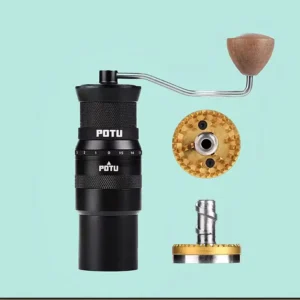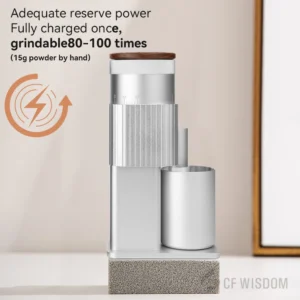Understanding Espresso Grind: The Foundation of Great Espresso
The perfect espresso shot begins long before you press the brew button. It starts with the grind—a critical yet often overlooked component that can make or break your espresso experience. The ideal espresso grind is remarkably fine, resembling powdered sugar or fine table salt in texture. When rubbed between your fingers, it should feel silky with a slight grittiness and have a tendency to clump together naturally.
This fine consistency isn’t just for show—it serves a crucial function in the brewing process. Espresso machines force hot water through coffee grounds at high pressure (typically 9 bars), with the entire extraction happening in just 25-30 seconds. To achieve proper extraction in this brief window, the grind must create the right amount of resistance.
The science behind this comes down to surface area. With particle sizes ranging from 200-400 microns (0.2-0.4mm), finely ground coffee exposes more surface area to water, allowing for:
- Proper extraction of flavor compounds
- Adequate resistance to create necessary pressure
- Consistent flow rate for balanced extraction
- Development of the rich crema that tops a perfect shot
When examining proper espresso grind, you’ll notice a uniform appearance with particles that stick together slightly but still separate easily. This visual and tactile assessment serves as your first indicator of whether your grind is in the ballpark for quality espresso.
Understanding the foundational information on espresso grind precision helps create a framework for all the adjustments you’ll make while perfecting your technique. Having the right tools specifically designed for achieving proper espresso grind is equally important, as we’ll explore throughout this guide.
The Consequences of Incorrect Grind Size
Getting your grind size wrong doesn’t just result in a less-than-perfect cup—it fundamentally alters the chemistry of your extraction and can create dramatically different results. Let’s examine what happens when your grind deviates from the ideal.
When Your Grind is Too Coarse
When espresso grounds are too coarse, water flows through them too quickly, resulting in under-extraction:
- Shot timing is noticeably fast (often under 20 seconds)
- The espresso appears pale with thin, disappearing crema
- The taste profile is predominantly sour and lacks depth
- The body feels watery without the rich mouthfeel of proper espresso
- The spent puck appears loose and falls apart easily when knocked out
Under-extraction happens because water finds channels through the coffee bed, bypassing much of the coffee and failing to extract the full range of flavors. What you taste is primarily the bright, acidic compounds that extract first, without the balancing sweetness and complexity that should follow.
When Your Grind is Too Fine
Conversely, when grounds are too fine, you encounter over-extraction problems:
- The machine struggles to push water through (choking) or extraction is extremely slow (over 35 seconds)
- The resulting espresso is dark with an excessively dark, sometimes patchy crema
- The flavor becomes noticeably bitter, astringent, or even ashy
- The spent puck appears muddy and overly compact
- You might notice significantly reduced volume in your cup
Over-extraction occurs when water remains in contact with the coffee for too long, pulling out undesirable compounds that create bitterness. The excessive resistance can also cause channeling as water seeks the path of least resistance, paradoxically resulting in both over- and under-extraction in different parts of the puck.
Understanding these consequences helps diagnose issues with your espresso. Referencing a visual guide for proper vs. improper grind sizes can be incredibly helpful in making the necessary adjustments to achieve that perfect balance.
How to Achieve and Assess the Recommended Espresso Grind
Achieving the ideal espresso grind requires a methodical approach, careful assessment, and ongoing adjustments. Let’s break down the process into manageable steps:
Starting Point and Initial Setup
- Begin with your grinder at a setting that produces powder-like grounds similar to fine table salt
- Prepare your initial shot using your standard dose (typically 18-20g for a double shot)
- Before committing to a full extraction, perform the pinch test: take a small amount of ground coffee and pinch it between your fingers—it should clump slightly but still break apart
- Always purge your grinder briefly when making adjustments to clear out any old grounds
Key Assessment Metrics
Evaluating your espresso grind comes down to three primary indicators:
1. Shot Timing: The extraction should take approximately 25-30 seconds from the moment you start your machine to when you achieve your target volume (typically 1:2 ratio of coffee to espresso).
2. Visual Assessment: Watch how the espresso flows—it should resemble warm honey in consistency, not rushing out like water or dripping painfully slowly.
3. Taste Evaluation: Ultimately, taste is your final judge:
– Sour, bright, watery = likely too coarse
– Bitter, harsh, astringent = likely too fine
– Balanced sweetness with pleasant acidity = properly dialed in
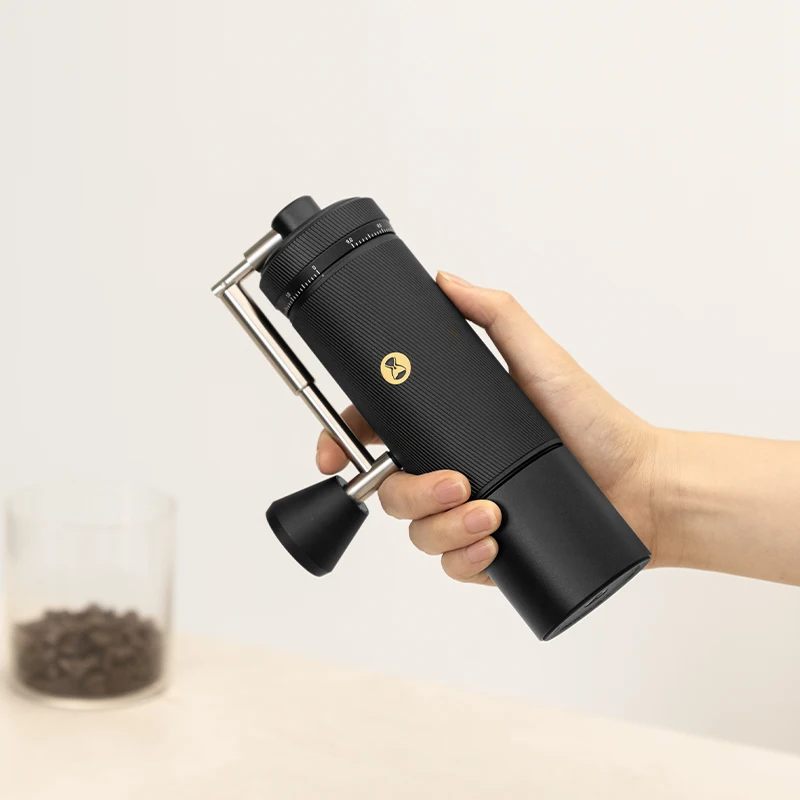
The Pinch Test Technique
The pinch test is a valuable hands-on assessment tool:
- Take a small amount of ground coffee in your fingers
- Pinch it together gently and then release
- For espresso, the grounds should:
– Stick together slightly when pinched
– Form small clumps that break apart with light pressure
– Not be so fine that they compact into a solid mass
– Not be so coarse that they immediately fall apart
Tracking Your Adjustments
Keep a simple log of your adjustments to build understanding of your equipment:
– Grind setting used
– Dose weight
– Shot time
– Taste notes
– Adjustments made
This systematic approach to techniques for systematically adjusting espresso grind eliminates guesswork and builds your expertise over time. Having the right tools designed for precision grinding adjustments makes this process much more manageable and repeatable.
Factors That Influence Your Ideal Espresso Grind Setting
Even when you’ve found what seems like the perfect grind setting, you’ll discover that espresso preparation is never static. Several variables can affect your ideal grind, requiring ongoing adjustments.
Bean Characteristics
Different coffee beans require different grind settings due to their unique properties:
- Roast Level: Darker roasts tend to be more brittle and extract more easily, often requiring a slightly coarser grind than lighter roasts.
- Bean Age: Fresh beans contain more CO2 and create more resistance, potentially needing a slightly coarser grind than beans that are several weeks old.
- Origin and Density: High-altitude, dense beans often need a finer grind than lower-grown, less dense varieties.
- Processing Method: Honey and natural processed coffees may extract differently than washed coffees, sometimes requiring grind adjustments.
Machine Variations
Your equipment significantly impacts grind requirements:
- Pressure Profiles: Machines with different pressure capabilities (9-bar standard vs. machines with pre-infusion or variable pressure) require different grind adjustments.
- Basket Design: Precision baskets, single vs. double baskets, and different hole patterns all influence the ideal grind.
- Temperature: Higher brewing temperatures extract coffee more efficiently, sometimes allowing for slightly coarser grinds.
Environmental Factors
The environment around you plays a surprising role:
- Humidity: Higher humidity can cause grounds to absorb moisture and swell, potentially requiring a coarser grind to prevent over-extraction.
- Ambient Temperature: Cold environments can affect both bean temperature and grinder performance, often requiring adjustment.
- Altitude: Higher altitudes can affect water boiling temperature and extraction dynamics.
Understanding how grind size affects espresso allows you to make informed adjustments as these variables change. What worked perfectly yesterday might need slight tweaking today due to any of these factors.
The Essential Tool: Why a Quality Burr Grinder is Non-Negotiable
When it comes to espresso preparation, no single investment impacts your results more than your grinder. The difference between a quality burr grinder and inferior alternatives is dramatic and directly affects every aspect of your espresso.
Burr Grinders vs. Blade Grinders
| Feature | Burr Grinder | Blade Grinder |
|---|---|---|
| Grind Consistency | Uniform particles | Highly inconsistent |
| Particle Size Control | Precise, adjustable | Limited, unpredictable |
| Heat Generation | Minimal heat transfer | Significant heat |
| Extraction Quality | Even, balanced | Uneven, mixed extraction |
| Espresso Suitability | Essential | Unsuitable |
| Retention (old grounds) | Minimal with good design | Can be significant |
| Price Range | $100-$500+ | $15-$50 |
The fundamental difference is that burr grinders crush beans between two burrs set at a precise distance, while blade grinders randomly chop beans with a spinning blade. For espresso, this difference is critical—blade grinders simply cannot produce the consistency needed for proper extraction.
Conical vs. Flat Burrs
Both designs can produce excellent espresso grounds, but they have different characteristics:
- Conical Burrs: More common in home and manual grinders, producing slightly more textured grounds with marginally more fines, potentially creating more body.
- Flat Burrs: Found in many commercial and high-end home grinders, creating very uniform particle size for clean, clear flavor clarity.
Key Features for Espresso Grinders
When selecting a grinder specifically for espresso, look for:
- Adjustment Precision: Espresso requires micro-adjustments that not all grinders can achieve
- Burr Quality: Materials like hardened steel or ceramic provide longevity and consistency
- Grind Consistency: Particularly important for preventing channeling during extraction
- Low Retention: Ensures you’re not mixing old and new grounds
- Build Quality: Stability during grinding ensures consistent results
Our specialized grinders designed for espresso preparation focus on these critical features to help you achieve consistent, quality results. Remember that even the finest espresso machine cannot compensate for poor grind quality—it truly is the foundation of exceptional espresso.
Espresso Grind in Context: A Comparison with Other Brew Methods
Understanding where espresso fits in the spectrum of coffee grinding helps illustrate just how specialized this brewing method is. Each preparation technique requires a specific grind texture to achieve optimal extraction.
From coarsest to finest, here’s how different brewing methods compare:
| Grind Size | Texture Comparison | Brewing Method | Typical Extraction Time |
|---|---|---|---|
| Extra Coarse | Rock salt | Cold brew | 12-24 hours |
| Coarse | Sea salt | French press | 4-5 minutes |
| Medium-Coarse | Rough sand | Clever dripper | 3-4 minutes |
| Medium | Regular sand | Drip coffee | 2-4 minutes |
| Medium-Fine | Table salt | Pour-over | 2-3 minutes |
| Fine | Fine table salt | Moka pot | 1 minute |
| Extra Fine | Powdered sugar | Espresso | 25-30 seconds |
| Turkish | Flour-like powder | Turkish coffee | Varies |
As you can see, espresso requires one of the finest grinds of any brewing method, surpassed only by Turkish coffee. This extreme fineness is necessary because of espresso’s unique combination of high pressure and short contact time.
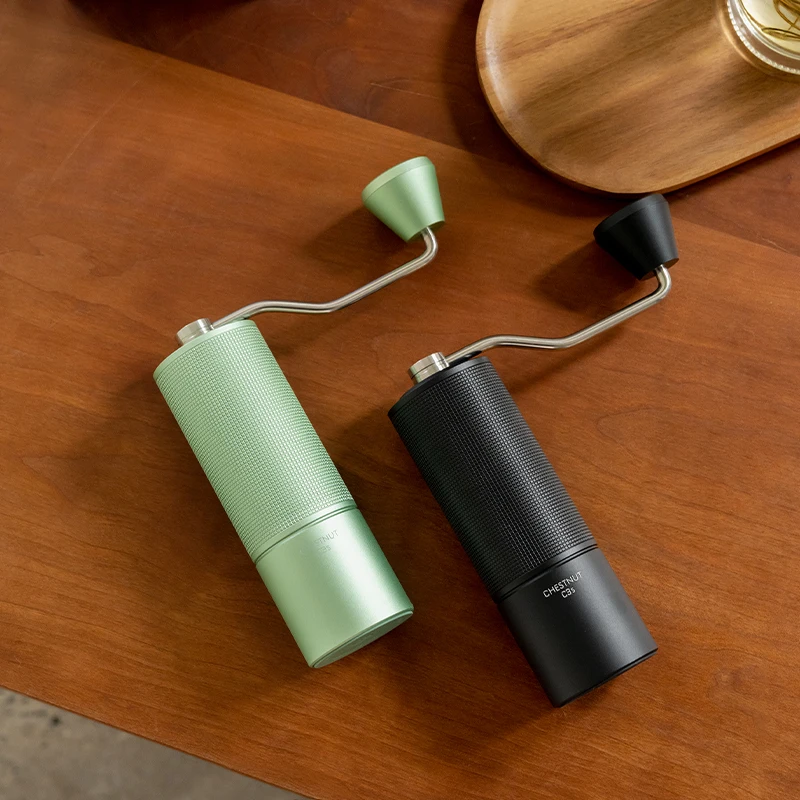
Methods adjacent to espresso in grind requirements include:
- Moka Pot: Uses a slightly coarser grind than espresso but still quite fine
- AeroPress: Can use espresso-fine grind for certain recipes, particularly when using pressure
- Lever Machines: Sometimes require slightly different grind than pump espresso machines
Understanding the definitive guidance on proper espresso grind settings helps contextualize why this brewing method demands such precision. Having grinders capable of achieving proper texture for various methods allows you to explore different brewing styles while ensuring each has the optimal grind texture.
Troubleshooting Common Espresso Grind Issues
Even experienced baristas encounter espresso issues related to grind size. Here are solutions to the most common problems:
Fast Extraction (Under 20 Seconds)
Problem: Water flows through the puck too quickly, resulting in sour, weak espresso.
Solution:
1. Make your grind finer in small increments
2. Ensure you’re using enough coffee (18-20g for a double shot)
3. Check that your distribution is even before tamping
4. Apply consistent tamping pressure
5. Verify your machine is reaching proper brewing temperature
Slow Extraction or Machine Choking
Problem: Water struggles to flow through, extraction takes over 35 seconds, or machine stalls.
Solution:
1. Adjust grind slightly coarser
2. Verify you’re not overdosing the basket
3. Ensure your shower screen is clean and not restricting flow
4. Check that you’re not tamping with excessive pressure
5. Examine your grinder for buildup that might be producing too many fines
Inconsistent Shot Times
Problem: Sequential shots with identical settings produce widely varying flow rates.
Solution:
1. Check your grinder for retention issues (old grounds mixing with fresh)
2. Ensure consistent distribution and tamping technique
3. Verify your dosing is consistent (use a scale)
4. Consider whether your grinder needs cleaning or burr alignment
5. Allow the machine to fully heat up between shots
Channeling
Problem: Water finds paths of least resistance through the puck, causing uneven extraction.
Solution:
1. Ensure even distribution before tamping
2. Check for clumping in your grounds and break them up if necessary
3. Use a distribution tool to create an even surface
4. Make sure your tamp is level
5. Consider whether your grind is too fine, causing excessive pressure
Following these solutions for timing-related extraction problems can help resolve most common issues. Remember that sometimes the solution involves addressing multiple factors simultaneously.
Practical Tips for Mastering Your Espresso Grind
Always grind immediately before brewing
Espresso grounds begin oxidizing within minutes, losing aromatic compounds and critical flavors. The difference between pre-ground and freshly ground coffee is particularly pronounced in espresso due to its concentrated nature.Make incremental adjustments
When dialing in your grind, make small, methodical changes. Moving your grinder adjustment by just one small increment can dramatically impact extraction. Wait to see the results of one change before making another.Embrace experimentation
Keep notes on different coffees and how they perform at various grind settings. This builds your intuition over time and helps you adjust more quickly for new beans.Clean your grinder regularly
Coffee oils build up inside grinders and can affect consistency and flavor. For home users, a monthly cleaning keeps your grinder performing optimally. More frequent cleaning may be necessary for very oily dark roasts.Purge between significant adjustments
When making grind adjustments, especially toward a finer setting, run a small amount of beans through to clear any grounds at the previous setting. This prevents mixing different grind sizes in your portafilter.
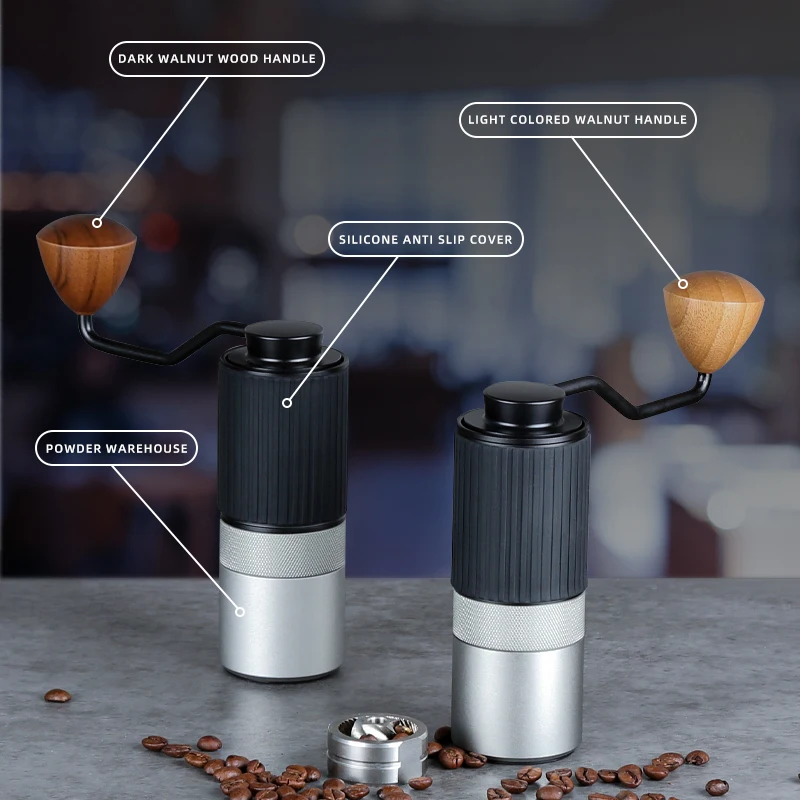
Fine Adjustment Hand Grinder, Precision Manual Grinder, Travel Coffee Grinder
Price range: $185.11 through $494.63 Select options This product has multiple variants. The options may be chosen on the product pageHand Burr Grinder, Hand Crank Coffee Grinder, Manual Espresso Grinder, Portable Coffee Grinder
Price range: $262.72 through $300.22 Select options This product has multiple variants. The options may be chosen on the product pageManual Burr Mill, Manual Coffee Grinder Stainless Steel, Manual Coffee Mill Grinder, Mechanical Coffee Grinder
Price range: $127.26 through $130.32 Select options This product has multiple variants. The options may be chosen on the product pageHand Burr Grinder, Manual Coffee Grinder Stainless Steel, Precision Manual Grinder
Price range: $183.64 through $187.52 Select options This product has multiple variants. The options may be chosen on the product pageHand Crank Coffee Grinder, Manual Burr Mill, Manual Coffee Bean Grinder
Price range: $2,053.84 through $2,918.42 Select options This product has multiple variants. The options may be chosen on the product page
Remember that dialing in espresso is an ongoing process rather than a one-time achievement. Beans change as they age, environmental factors fluctuate, and even machine performance can vary slightly day to day. The best espresso makers embrace this variability and make the necessary adjustments.
Having tools designed for precise, consistent grinding makes this process much more enjoyable and successful. At Savor Suite, we understand that the journey to perfect espresso requires equipment that can deliver consistent results while offering the precision necessary for fine adjustments.
Frequently Asked Questions About Espresso Grind
Can I use pre-ground coffee for espresso?
Pre-ground coffee is generally unsuitable for espresso for several reasons. First, it’s rarely ground to the precise fineness required. Second, pre-ground coffee quickly loses aromatics and oxidizes, resulting in flat flavors. Third, you can’t adjust pre-ground coffee to dial in your shot. For quality espresso, grinding immediately before brewing is essential.
How often should I adjust my espresso grind?
You’ll need to adjust your grind when changing coffee beans, when beans age (typically becoming drier and requiring a finer grind over time), and when environmental conditions like humidity change significantly. Many experienced baristas make small adjustments daily to maintain optimal extraction.
How does tamping pressure relate to grind size?
While proper tamping is important, it cannot compensate for incorrect grind size. Think of tamping as creating evenness for consistent extraction, while grind size controls the actual flow rate. If your shots are running too fast, tamping harder is not the solution—adjusting to a finer grind is more effective.
My grinder doesn’t go fine enough for espresso. What can I do?
If your grinder can’t achieve a fine enough setting, consider a few options: using a slightly higher dose of coffee to increase resistance, trying a different tamping technique, or exploring pressurized portafilter baskets which are more forgiving of grind size. Ultimately, investing in an espresso-capable grinder is the best long-term solution.
How does bean freshness affect my grind setting?
Very fresh beans (1-7 days after roasting) contain significant CO2 which creates resistance during extraction and may require a slightly coarser grind. As beans age (2-4 weeks), they typically require progressively finer grinding to maintain the same extraction time. Beyond 4-6 weeks, most beans begin to lose significant flavor regardless of grind adjustments.
For more detailed explanations of grind settings for common questions, explore our comprehensive resources. Each coffee and setup presents unique variables, but these principles provide a strong foundation for troubleshooting.
Conclusion: The Journey to Perfect Espresso Starts with the Grind
The path to exceptional espresso begins with mastering the grind—perhaps the single most influential factor in your brewing process. As we’ve explored throughout this guide, achieving the proper texture requires understanding, practice, and the right equipment.
Remember that espresso preparation is both science and art. The science provides the parameters—fine, consistent grounds that create appropriate resistance for 25-30 second extractions. The art comes in the adjustments you make based on taste, appearance, and flow to craft a shot that delights the senses.
Every variable we’ve discussed—from bean characteristics to environmental factors—contributes to the complex equation that results in that perfect cup. By embracing the process and understanding these principles, you’ll be equipped to create consistently excellent espresso.
Invest in quality tools for continuing the espresso journey, practice your technique diligently, and remember that even small improvements in your grind can dramatically improve your results. The reward—a perfectly balanced shot with rich crema and complex flavors—is well worth the effort.


